Chapter: 11th Home Science : Chapter 3 : Food Science
Methods of Cooking
METHODS OF COOKING
Cooking has been practiced since times
immemorial. The ancient man ate only raw food.Once a piece of meat fell into
the fire accidentally and got roasted. The ancient man ate this piece of
roasted meat and liked it. Thus began the process of cooking. It has evolved a
lot since then.
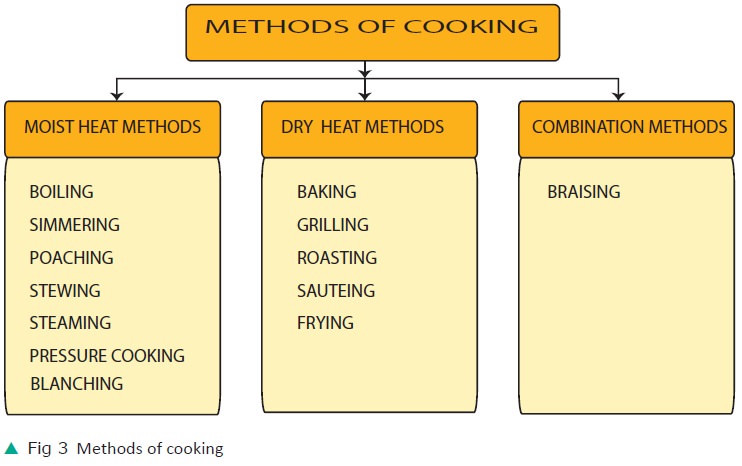
Cooking offers a wide variety of foods. For
example food items like roti, puri, paratha, rice, pulao, pulses, vegetable, salad,
chutney, pickle, curd, butter milk, fruits, etc.are prepared from different
food.
Boiled rice tastes different from jeera rice
or pea pulao because these are cooked differently. Similarly, a chapatti tastes
different from a puree or paratha, again because all these are cooked
differ-ently. Generally, vegetables like tomatoes, cucumber and fruits are best
eaten raw while wheat, rice, pulses, potatoes and other vegetables must be
cooked. Cooking providing variety and the main objectives of cooking are:
·
Improves the taste and food quality.
·
Cooking food to the required tempera-ture for a required length
of time can destroy all harmful microorganisms in food.
·
Cooking improves digestibility.
·
Cooking increases variety.
1. Moist Heat Methods
Boiling:
Boiling is cooking
foods by just immersing them in water at 100°C and maintaining the water
at that tem-perature till the food is tender. It does not require special skill
and equipment. It is time consuming.
Merits:
·
Simple method, does not require skill or any particular
equipment.
·
Uniform cooking can be achieved.
Demerits:
1.
Continuous boiling damages the struc-ture and texture of food.
2.
There is a loss of vitamins B and C if the cooking water is
discarded.
3.
It is time consuming and may lead to increased use of fuel.
4.
Loss of colour —Water soluble pig-ments may be lost during
cooking.
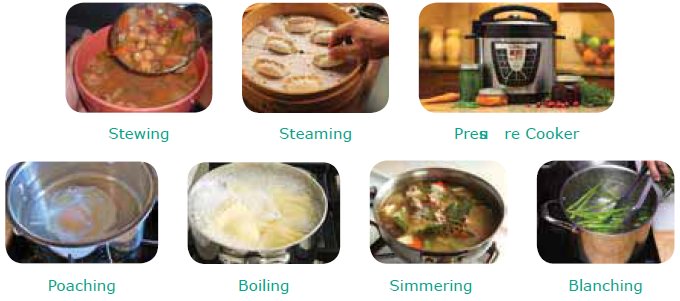
ii) Simmering
When food is cooked in a pan with a well
fitted lid at a temperature just below the boiling point 82°–99°C, it is known
as simmering. It is a useful method when foods have to be cooked for a long
time to make it tender. (eg) vegetables.
Merits:
1.
Food can be cooked with less chances of burning.
2.
The flavour of the food can be enhanced.
3.
Does not require any skill or specific equipment.
Demerits:
1.
Takes a long time for cooking the food.
2.
Precaution must be taken to ensure that the food does not get
burnt.
iii) Poaching
This involves cooking in the minimum amount of
liquid at a temperature of 80°– 85°C. Foods generally poached are eggs and
fish.
Merits:
1.
No special equipment is needed.
2.
It is a quick method of cooking and thus saves fuel.
3.
Poached foods are easily digested as no fat is added.
Demerits:
1.
Poached foods may not appeal to ev-erybody as they are bland to
taste.
2.
Foods can get burnt if not monitored closely.
3.
Water soluble nutrients may be lost if they are leached into the
water.
iv) Stewing
This is a gentle method of cooking in a pan
with a tight fitting lid, using small quan-tities of liquid to cover only half
the food. The liquid is brought to a boiling point and then the heat applied is
reduced to maintain the cooking at simmering temperature ie., 98°C. Apples can
be cooked by this method.
Merits:
1.
Loss of nutrients is avoided as the wa-ter used for cooking is
not discarded.
2.
Flavour is retained.
Demerits:
·
The process is time consuming and there is wastage of fuel.
v) Steaming
This method requires the food to be cooked in
steam. This is generated from vigorously boiling water or liquid in a pan so
that the food is completely surrounded by steam and not in contact with the
water or liquid. Here the food gets cooked at 100 degrees.
Merits:
·
Less chances of burning.
·
Texture of food is better, as it is made light and fluffy.
·
Saves time and fuel.
·
Steamed foods like idli and idiappam have very negligible fat
and are easy to digest, and are good for children, elderly and therapeutic
diets.
Demerits:
1.
Steaming equipment is required.
2.
This method is limited to the prepara-tion of selected foods.
vi) Pressure cooking
In pressure cooking escaping steam is trapped
and kept under pressure so that the temperature of the boiling water and steam
can be raised above 100°C thus reducing cooking time. Foods cooked in pressure
cooker are rice, dhal, vegetables and meat.
Merits:
1.
Cooking time is less compared to oth-er methods.
2.
Nutrient and flavour loss is minimized.
3.
Conserves time and fuel and different items can be cooked at the
same time.
4.
Less chance of burning.
5.
Constant monitoring is not necessary.
Demerits:
1.
The initial investment cost may not be affordable by everybody.
2.
Knowledge of the use, care and main-tenance of the cooker is
required to prevent accidents.
3.
Careful watch on the cooking time is necessary to prevent over
cooking.
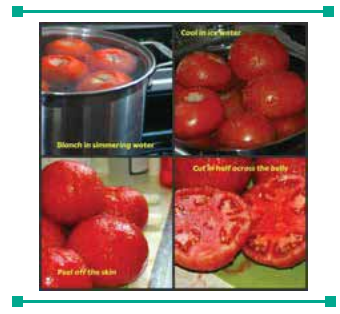
vii) Blanching
In meal preparation, it is often necessary
only to peel off the skin of fruits and veg-etables without making them tender.
This can be achieved by the method of blanch-ing. In this method food is
dropped in boiling water for 5 seconds to 2 minutes depending on the texture of
food. This helps to remove the skin without softening the food.
Blanching can also be done by pouring enough
hot water on the food to immerse it for some time or subjecting foods to
boiling temperatures for short periods and then immediately immersing them in
cold water. This process causes the skin to become loose and then can be peeled
off easily.
Merits:
1.
Peels can easily be removed to improve digestibility.
2.
Destroys enzymes that bring about spoilage.
3.
Texture can be maintained, while im-proving the colour and
flavor of the food.
Demerits:
Loss of nutrients if cooking water is
discarded.
2. Dry Heat Methods
In this either air or fat is used as the
medium of cooking.
Air as a Medium of Cooking
i) Grilling
Grilling consists of placing the food below or
above or in between a red-hot surface. This results in the browning of the
food.
Merits:
·
Quick method of cooking.
·
It improves the appearance, texture and flavour of the food.
·
Minimum oil is used.
Demerits:
·
Foods can be burnt due to carelessness.
·
Grilling denatures the proteins reduc-ing their availability.
ii) Pan broiling or roasting
When food is cooked uncovered on heated metal
or a frying pan, the method is known as pan-broiling, (e.g) chapathis.
Merits:
·
Quick method of cooking.
·
It improves the appearance, texture and flavor of the food.
·
Minimum oil is used.
Spices are easily powdered if they are first
roasted.
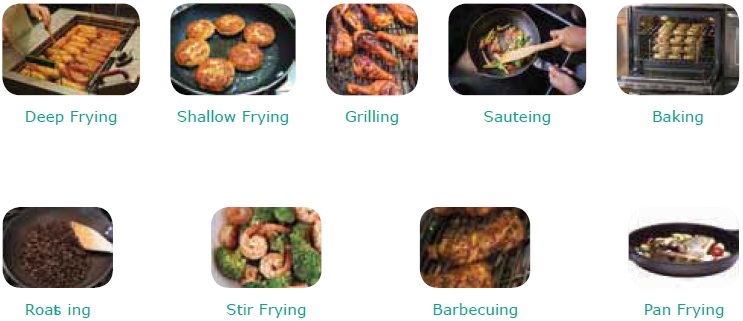
Demerits:
·
Foods can be burnt due to carelessness.
·
Grilling denatures the proteins.
iii) Baking
Here food gets cooked by hot air inside the
oven. Foods baked are generally brown and crisp on the top and soft and porous
in the centre, (eg) cakes and breads. The temperature that is nor-mally
maintained in the oven is between 120°C–260°C.
Merits:
·
It gives a unique flavour to food.
·
Foods are made light and fluffy – cakes, rolls, custard, bread.
·
Certain foods can be prepared only by this method – bread,
cakes.
·
Uniform and bulk cooking can be achieved.
·
Flavour and texture of the food is en-hanced.
·
A variety of dishes can be made.
Demerits:
·
Special equipment like
oven is re quired.
·
Baking skills are necessary to obtain a product with ideal
texture, Flavour and colour characteristics.
·
Careful monitoring needed to prevent scorching.
Fat as a Medium of Cooking
i) Sauteing
This method involves cooking in just enough of
oil to cover the base of the pan. Foods cooked by sauteing are generally
vegetables used as side dishes in a menu.
Merits:
·
Takes less time.
·
Simple technique.
·
Minimum oil is used.
·
Constant monitoring is needed to pre-vent scorching.
Demerits:
Constant monitoring is needed to pre-vent
scorching.
ii) Shallow and deep fat frying
Here food is cooked on a tava with little oil
(eg) chapathi, cutlets, etc. Deep fat frying Food is totally immersed in hot
oil and cooked. The temperature maintained is 180°–220°C (eg.) Samosa, Bajji,
etc. The taste of the food is improved along with texture.
Merits:
·
Very quick method of cooking.
·
The calorific value of food is increased as fat is the medium of
cooking.
·
It gives a delicious flavour and appear-ance to the food.
·
Taste and texture are improved.
Demerits:
·
Constant monitoring is needed to pre-vent scorching.
·
The food may become soggy due to too much fat absorption.
·
Fried foods are not easily digested.
Repeated use of heated oils will have ill
effects on health.
3. Combination Method
i) Braising
Braising is a combined method of roasting and
stewing in a pan with a tight fitting lid. Meat is cooked by this method.
Examples of foods cooked by braising are:
1. Uppuma : Roasting and boiling
2. Cutlet : Boiling and shallow frying.
3. Vermicelli payasam : Roasting and simmering.
4. Innovative Methods
i) Microwave Cooking
Electromagnetic waves from a power source called magnetron are absorbed by the food and food becomes hot at once. Microwave cooking enhances the flavour of food because it cooks quickly with little or no water and thus preserves the natural colour of vegetables and fruits.
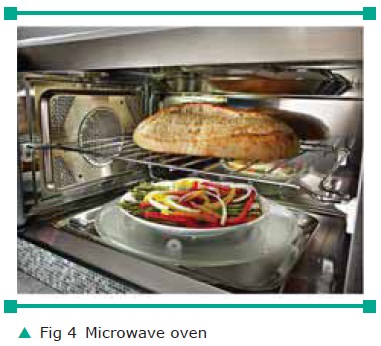
Merits:
·
Quick method – 10 times faster than the conventional method. So
loss of nutrients can be minimized.
·
Only the food gets heated and the oven does not get heated.
·
Foods get heated uniformly.
·
Leftovers can be reheated without chang-ing the flavor and
texture of the product.
·
Microwave cooking enhances the fla-vor of the food because it
cooks quick-ly with little or no water.
Demerits:
·
Baked products do not get a brown surface.
·
Microwave cooking cannot be used for simmering, deep frying or
stewing.
·
Flavour of all ingredients do not blend well as the cooking time
is too short.
ii) Solar Cooking
Solar cooker works on solar energy. Solar
cooker consists of well insulated box, the inside of which is painted dull
black and
The
temper-ature maintained is around 140°C. Cost of the cooker and the maintenance
cost is low. It takes longer time and special ves-sels need to be used.
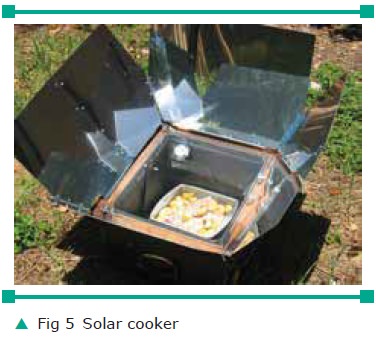
Merits:
·
Simple techniques – requires no spe-cial skill.
·
Cost effective as natural sunlight is the form of energy
·
Original flavour of food is retained
·
There is no danger of scorching or burning
·
Loss of nutrients is minimum as only little amount of water is
used in cooking
Demerits:
·
Special equipment is needed
·
Slow cooking process
·
Cannot be used in the absence of sun-light-rainy season, late
evening and night
Related Topics